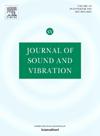Intrinsic mechanisms of vibrational mode jumping in sandwich panels
IF 4.3
2区 工程技术
Q1 ACOUSTICS
引用次数: 0
Abstract
This paper focuses on the mode jumping and natural frequency loci veering properties of the sandwich panel with three dimensional (3D) Kagome truss core under two different boundary conditions. The first-order shear deformation theory is employed to formulate the equations of motion and the general elastic boundary conditions are taken into account, which are simulated by a series of rotational and translational springs. The Rayleigh-Ritz method is deployed to derive the mode shape functions for the sandwich panel, where displacements and rotations of the structure are expressed as combination of the admissible functions composed of Fourier series and supplemental by Legendre polynomials. By solving the characteristic equations, the mode shapes and natural frequencies of the 3D-Kagome truss core sandwich panel are determined. Specifically, the present approach can provide a unified solution scheme to address the vibration issues of the moderately thick plates subjected to arbitrary boundary conditions including classical ones and with elastic constraints, which can be conveniently achieved by adjusting the stiffnesses of the constraint springs. From the obtained results, the most noteworthy ones are modal shifting or mode jumping and frequency loci veering, which are observed for the first time in the vibration modes of the tuned periodic panel, comparing with those in buckling modes of the beams or plates, vibration modes of mistuned periodic structures and mistuned rotor systems. Modal assurance criteria (MAC) are applied to check the spatial coincidence and correlation of the modal vectors before and after the mode jumping. Finally, the accuracy of the theoretical results are verified by vibration experiments and ABAQUS simulations.
夹芯板振动模态跳变的内在机理
研究了三维Kagome桁架芯夹芯板在两种不同边界条件下的模态跳变和固有频率轨迹偏移特性。采用一阶剪切变形理论,在考虑一般弹性边界条件的情况下,建立了运动方程,并采用一系列旋转和平移弹簧进行了模拟。采用Rayleigh-Ritz方法推导了夹层板的模态振型函数,其中结构的位移和旋转用由傅里叶级数和勒让德多项式组成的可容许函数的组合来表示。通过求解特征方程,确定了三维kagome桁架芯板的模态振型和固有频率。具体而言,该方法可以为任意边界条件下的中厚板振动问题提供一个统一的解决方案,包括经典边界条件和弹性约束,通过调整约束弹簧的刚度可以方便地实现。从得到的结果来看,与梁或板的屈曲模态、失谐周期结构和失谐转子系统的振动模态相比,最值得注意的是在调谐周期板的振动模态中首次观察到模态移位或模态跳变和频率轨迹偏移。采用模态保证准则(MAC)检查模态跳变前后模态向量的空间一致性和相关性。最后,通过振动实验和ABAQUS仿真验证了理论结果的准确性。
本文章由计算机程序翻译,如有差异,请以英文原文为准。
求助全文
约1分钟内获得全文
求助全文
来源期刊

Journal of Sound and Vibration
工程技术-工程:机械
CiteScore
9.10
自引率
10.60%
发文量
551
审稿时长
69 days
期刊介绍:
The Journal of Sound and Vibration (JSV) is an independent journal devoted to the prompt publication of original papers, both theoretical and experimental, that provide new information on any aspect of sound or vibration. There is an emphasis on fundamental work that has potential for practical application.
JSV was founded and operates on the premise that the subject of sound and vibration requires a journal that publishes papers of a high technical standard across the various subdisciplines, thus facilitating awareness of techniques and discoveries in one area that may be applicable in others.
 求助内容:
求助内容: 应助结果提醒方式:
应助结果提醒方式:


